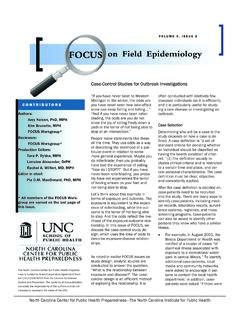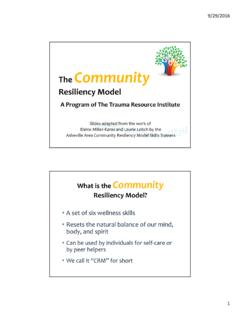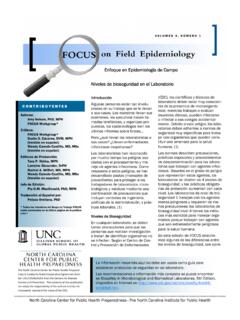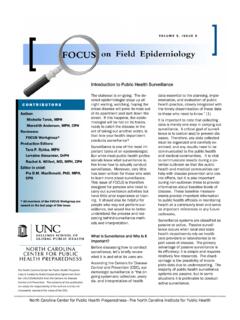Transcription of Data Analysis Basics: Variables and Distribution
1 North Carolina Center for Public Health Preparedness The North Carolina Institute for Public Health Data Analysis Basics: Variables and Distribution VOLUME 3, issue 5 How do you know whether a chemi-cal spill in a factory caused illness in the workers? How do you know what food caused an outbreak of salmo-nella in your community? In a field investigation, you often want to know whether a particular exposure ( , a chemical spill) is associated with any possible illness, or which of many possible expo-sures is associated with a particular illness ( , what was the potential cause of an outbreak of salmonella). You start the process of answering these questions by choosing a study design, developing a questionnaire, and gathering data in the field.
2 All of these were discussed in previous issues of FOCUS. Once these steps are completed and you have col-lected your data, what comes next? Unlike the depiction of epidemiolo-gists in some television shows, after gathering data you don t simply have a brilliant flash of insight and solve the outbreak; you actually have to sit down and analyze that data! It is not the most glamorous part of the epi-demiologist s job, but when the data lead to the source of an outbreak, the Analysis is definitely rewarding. This issue of FOCUS will take you through the basic steps of descrip-tive data Analysis , including types of Variables , basic coding principles and simple univariate data Analysis .
3 Types of Variables Before delving into Analysis , let s take a moment to discuss Variables . This may seem a trivial topic to those with Analysis experience, but vari-ables are not a trivial matter. Much Author: Kim Brunette, MPH Amy Nelson, PhD, MPH FOCUS Workgroup* Reviewers: FOCUS Workgroup* Production Editors: Tara P. Rybka, MPH Lorraine Alexander, DrPH Rachel A. Wilfert, MD, MPH Editor in chief: Pia MacDonald, PhD, MPH * All members of the FOCUS Work-group are named on the last page of this issue . The North Carolina Center for Public Health Prepared-ness is funded by Grant/Cooperative Agreement Num-ber U90/CCU424255 from the Centers for Disease Control and Prevention.
4 The contents of this publication are solely the responsibility of the authors and do not necessarily represent the views of the CDC. CONTRIBUTORS like people, Variables come in many different sizes and shapes. Most field epidemiology, however, relies on gar-den-variety continuous and categori-cal Variables . Continuous Variables are always nu-meric and theoretically can be any number, positive or negative (in real-ity, this depends upon the variable). Examples of continuous Variables are age in years, weight, blood pressure readings, indoor and outdoor tem-perature, concentrations of pollutants in the air or water, and other measure-ments. Categorical Variables contain informa-tion that can be sorted into catego-ries, rather like sorting information into bins.
5 Every piece of information belongs in one and only one bin. There are several types of categorical Variables : ordinal, nominal, and di-chotomous or binary. An ordinal variable is any categorical variable with some intrinsic order or numeric value. For example, we might categorize information on the educa-tional status of a group of people into a variable called EDUCATION. One person may not have graduated from high school, another might have graduated from high school but re-ceived no further education, a third could have some college education or have received some other post-secondary training, and another might have graduated from college. The education levels of all members of the group will fit neatly into these catego-ries, and the categories have an intrin-sic order.
6 A college graduate has more education than a high school graduate, and a high school graduate North Carolina Center for Public Health Preparedness The North Carolina Institute for Public Health Page 2 FOCUS ON FIELD EPIDEMIOLOGY has more education than someone who did not graduate from high school. Thus as the categories go from 1 to 5, the level of education increases. Other examples of ordi-nal Variables are: agreement (for example, strongly disagree, disagree, neutral, agree, strongly agree) rating (for example, excellent, good, fair, poor) frequency (for example, always, often, sometimes, never) or any other scale (for example, On a scale of 1 to 5, how much do you like peanuts?)
7 A nominal variable is a categorical variable without any intrinsic order. For example, say we have a variable called RESIDE that characterizes the part of the United States in which a person lives the Northeast, the South, the Mid-west, the Southwest, or the Northwest. The categories of this variable have no numeric value or order. Residence in the Northwest has no quantitative value compared to the Northeast. Other examples of nominal Variables include sex (male, female), nationality (American, Mexican, French), race/ethnicity (African American, Hispanic, White, Asian American), or favorite pet (dog, cat, fish, snake). A dichotomous, or binary variable is a categorical variable that has only 2 levels or categories.
8 Many dichotomous Variables represent the answer to a yes or no question. For example, Did you attend the church picnic on May 24? or Did you eat potato salad at the picnic? A variable does not have to be a yes/no variable to be dichotomous it just has to have only 2 categories, such as sex (male/female). Coding Once you have gathered your questionnaire or other data, you may choose to code the data for entry into a database. Coding is the process of translating the information gath-ered from questionnaires or other investigations into something that can be analyzed, usually using a computer program. Coding involves assigning a value to the infor-mation given in a questionnaire, and often that value is given a label.
9 In addition, coding can make the data more consistent. For example, if you have the question Sex? you might end up with the answers Male , Female , or M , F , etc. Coding will avoid such inconsistencies. A common coding system (code and label) for dichoto-mous Variables is the following: 0 = No 1 = Yes, where the number 1 is the value assigned, and Yes is the label or meaning of that value. Some like to use a system of ones and twos, where 1 = No 2 = Yes. This brings out an important point in coding. When you assign a value to a piece of information, you must also make it clear what that value means. In the first example given above, 1 = Yes, but in the second example, 1 = No.
10 Either way is fine, as long as it is clear how the data are coded. You can make it clear by creating a data dictionary as a separate file to accompany the dataset. Similarly, we might code the dichotomous variable for sex: 0 = Female 1 = Male Dichotomous Variables can also be dummy Variables . A dummy variable is any variable that is coded to have 2 levels, like the yes/no Variables and male/female vari-ables above. They can also be used to represent or stand in for more complicated Variables . This is especially useful when you have many values that are more meaningful when analyzed in terms of a yes/no response. For example, you may have collected data on the number of cigarettes smoked per week, with 75 different re-sponses ranging from no cigarettes at all to 3 packs a week, but you can recode these data as a dummy variable: 1 = Smokes (at all), 0 = Non-smoker.













